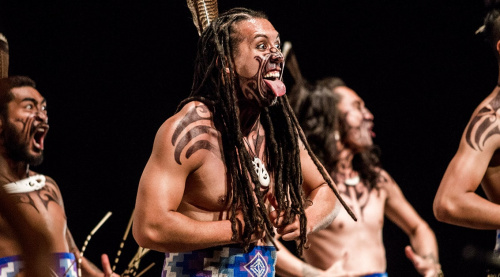Pūmanawa
Aotea Centre, Auckland Live, Auckland
21/03/2021 - 21/03/2021
Production Details
Pūmanawa brings together four brilliant kapa haka who embody the idea of legacy, talent and dedication to a centuries-old way of celebration.
Join Te Rōpū Manutaki, Te Iti Kahurangi, Tūwhitia kia Angitu and 2019 Te Matatini winners Ngā Tūmanako as they sing and haka with full voices, fierce wairua and boundless energy.
Hosted by Wī & Wā of Taringa Huruhuru.
About Kapa Haka
Kapa haka is an avenue to express and showcase heritage and cultural identity through song and dance, and a way to celebrate who and where we are in the world.
The concept of legacy and mātauranga tuku iho – knowledge handed down through generations – is powerful as we remember those who have come before us.
This event is particularly important as the annual kapa haka competition Te Matatini has been postponed until 2022.
Te Rōpū Manutaki, Te Iti Kahurangi, Tūwhitia kia Angitu and 2019 Te Matatini winners Ngā Tūmanako
Hosted by Wī & Wā of Taringa Huruhuru.
Te Reo Māori , Maori contemporary dance , Kapa Haka theatre , Dance ,
3 hrs 30 mins
Projection of a life-view
Review by Dr Mark James Hamilton 23rd Mar 2021
On the final afternoon of Auckland Arts Festival, a wide-ranging audience fill the Aotea Centre foyers with a buzz. Inside the vast auditorium, there are seats to spare and I am wondering how kapa haka will be on such a formal stage in such a cavernous space. Is this event a stopgap substitute? Is it an outlet for pent-up talent, because Covid 19 has suspended Te Matatini’s cycle of national competition? As the gathering unfolds, the space quickly becomes full to capacity with the art’s vibrancy. Four kapa perform in turn, joining in pairs to reappear before the interval and before the close. Kapa haka always speaks to te ao Māori through its integration of marae protocols. In the presence of Kīngi Tūheitia this dimension of the performance is deepened. The royal audience brings forward the scale of the day; the drama is about this nation’s evolution
Tūwhitia kia Angitu enter first onto the bare stage flooded with warm light. From the comfort of my cushioned chair, with excellent sightlines, I immediately enjoy details that have evaded me when baking in sunny competition stadiums. The gestural nuances in the action song create moments that speak lucidly – like well punctuated poetry. The confident layering of harmonies makes sonic sandwiches filled with rich intervals. The poi twirl in a complex composition that leaps and shifts haka-like to the sound of a guitar back being beaten steadily. The interconnections between the elements of kapa haka are woven tight.
With a simple innovation, Te Iti Kahurangi signal the core message of the day. Standing amongst the adults are children. The passing of the arts down the generations is made vivid. The fluency of the juniors is astonishing. Their engagement and animation are stunning. Kapa haka is not acting; each person performs as their self standing in their whakapapa. Yet there is an elevation of that self in the art, and the children’s charged expressions and confident finesse makes this transformation clear. It is far more than charisma that reaches me over the stage’s edge and across the stalls. It is a projection of a life-view experienced through the songs, actions and feelings.
Te Rōpū Manutaki wield their taiaha with precision and power. The men and women show that their martial skill is acquired through a web of training practices – drills for dexterity with contortions integrating thin short staffs, and rhythmic coordination mastered by throwing and catching short sticks. Then come the poi cutting crisp geometric patterns into the air. Their hypnotic beauty veils but never quite hides how such wrist control feeds too into becoming battle-ready to wield weapons.
Ngā Tūmanako make me see haka anew. The waves of challenge and presence ride out from their ranks spread across the whole stage’s great width. There is flow and momentum in their postures and gestures, then sudden locks. Each halt is not a stop but a pause packed ready to burst. The men’s vibration and tremors signal the force they hold in; explosions are held off and articulated instead into expression. And the words of the men and women’s calls are made huge by the embodiment invested in them. Speaking becomes a total action, top to toe aligned to the message.
In a finale of finales, all four groups join en masse to fill the stage. It is a marvel to see so many performers in movement and voice together. Such numbers tip the moment away from any sense of an entertainment. It becomes evident that kapa haka is an essential current in the renaissance of Māoritanga. A trio of warriors lead Sir Pita Sharples down the audience aisle. Accompanied by the call of karanga, he climbs to the stage. The evening becomes a special moment to acknowledge this revered leader, and for him to celebrate kapa haka and all it has done. He tells us of the ways in which it has combined with kōhanga reo and kura kaupapa Māori to restore te reo. He presents the performers before us as making momentous history, helping through their art to undo the damage done to generations of tangata whenua forbidden access to their own language. It is a milestone moment and a privilege to be present. His words before the King are a closing that is an address to the nation.
Copyright © in the review belongs to the reviewer





Comments